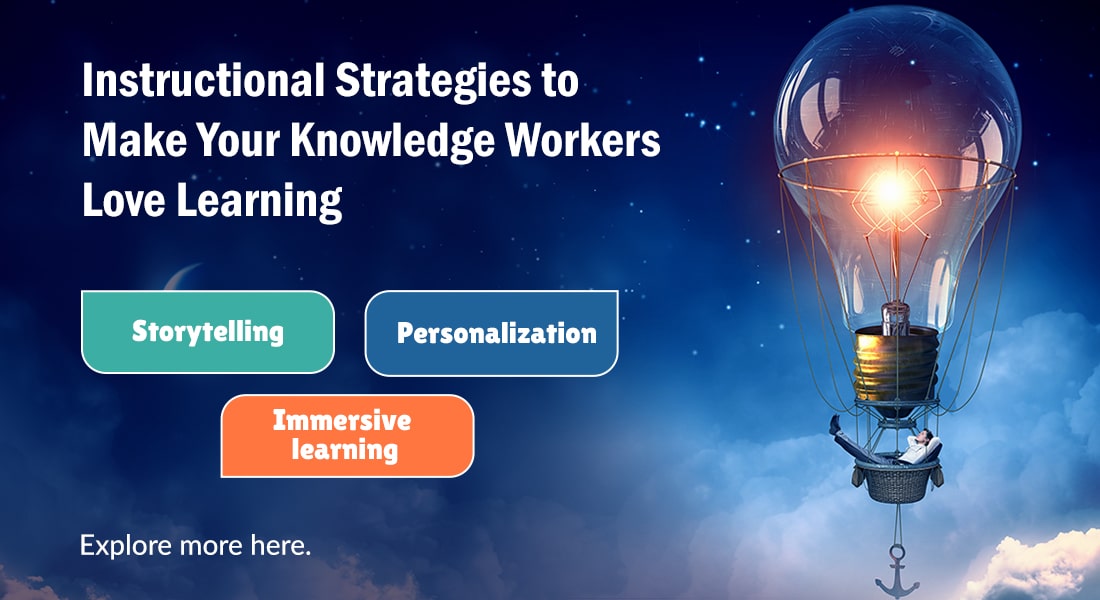Knowledge Workers Will Love these Instructional Strategies – Do You Offer Them?

In his book The Landmarks of Tomorrow, Peter Drucker defined “knowledge workers” as high-level workers who use the theoretical and analytical knowledge acquired through formal training to offer and develop products and services. We find knowledge workers in diverse fields such as web designers, engineers, writers, scientists, design thinkers and researchers, to name a few. Anyone who ‘thinks for a living’ can come under the umbrella of a knowledge worker.
As early as 1959, Drucker had predicted that their productivity and creativity will make knowledge workers valuable assets to organizations. Well, he wasn’t wrong! Knowledge workers are essential for global economy and their roles have expanded into all sectors. There is an increasing need for knowledge workers to perform organizational tasks, and with this, the need for their training too.
Explore online training trends for 2022!
As a training manager, you need to step up your game to cater to the corporate training needs of these thinkers. Functional and creative instructional strategies should be used to engage learners and offer sticky learning, in the classroom and online. The strategies need to involve learners emotionally, offer an experiential set up, and appeal to their creative side.
Online Learning for Knowledge Workers
Make it engaging through:
- Storytelling
- Immersive learning
- Personalization
- Recent trends
Let’s now look at some tried-and-tested instructional strategies that work wonders with them.
Cater to Your Knowledge Workers
1. Storytelling
This strategy presents content in the form of a story to engage learners and improve their understanding. It appeals to the creative minds of knowledge works and helps develop their critical thinking skills. Stories and narratives in training programs:
- Demonstrate how learners should act in a particular situation
- Use anecdotes and analogies to make abstract concepts easy to understand
- Offer learners visual metaphors which are a powerful tool to help them learn
- Lead to better retention as learners get emotionally invested in the subject matter
Examples of Storytelling in eLearning include the following.
Scenario-based eLearning
Scenarios in eLearning should be realistic and replicate the situations that knowledge workers deal with in their day-to-day jobs. They offer the learner a chance to practice crucial decision-making skills, and the feedback offered after each choice will help them take better, more informed decisions while performing their job tasks.
Ideal for:
ERP/Software Training, Product Training, Safety Training
Case Studies
Case studies are widely used and are very popular in employee training as they:
- Improve higher level thinking skills such as application, synthesis, and evaluation, so useful for knowledge workers
- Teach learners how to work as a team
- Test learners’ problem-solving skills
- Encourage learners to brainstorm an issue from multiple angles and come up with the best possible solution
Let’s now see how a knowledge worker can approach a case study it to get the most out of it.
- Find out the facts of the case and use these to build a logical framework to work with.
- Understand the dynamics of the case and take them into account while brainstorming a solution.
- Accurately define the problem and listen to fellow learners as they share their understanding.
- List a course of action that will lead to a solution.
- Make a SWOT analysis of the chosen path to a solution to test its efficiency.
2. Immersive Learning
It’s a well-known fact that learning can be enhanced by ‘immersing’ learners in a self-contained and simulated environment that helps them learn through experience. Experiential learning accounts for 55% in the 55:25:20 model of learning and development.
Here are some ways to offer immersive learning.
Simulations
Knowledge workers need to perform complex tasks right – every time. One way to help them do this is by allowing them to practice tasks in a simulated environment. ‘Learning by doing’ will ensure more effective learning and greater retention.
Simulation-based training works when:
- Knowledge workers need to master skill-based tasks (practice makes perfect!)
- The process is extremely complicated (where learners can benefit from experimentation)
- There is zero tolerance for error (when the outcome of errors is dangerous or expensive)
- You want to offer an active learning experience for your creative learners
Ideal for:
ERP/Software Training, Product Training, Safety Training
Learning through Exploration and Discovery (LEAD)
This strategy gives learners the flexibility to interact with different elements of the course layout and with the learning environment. Knowledge works can analyze and interpret information instead of memorizing.
Ideal for:
Employee Onboarding, Safety Training, Product Training
Virtual Reality
Virtual Reality (VR) provides a three-dimensional, computer-generated environment that learners can explore and interact with. It provides a truly immersive experience that enhances the quality of training. It can help knowledge workers observe and learn things that they would otherwise have missed in traditional training.
Virtual reality is ideally used in situations that are difficult or risky to practice in real-world conditions. It can provide a safe space for knowledge workers to explore complex tasks in a risk-free environment.
Ideal for:
Technical Training, Compliance Training
Augmented Reality
Augmented Reality (AR) superimposes digital or virtual elements on real elements through a transparent screen, like holograms or heads-up displays (HUD). AR devices are small and compact and can even be designed like regular glasses. Augmented Reality can increase employee engagement just as much as virtual reality. It is also a more affordable option than virtual reality.
Ideal for:
New Hire Orientation, Quality and Service Training, Safety Training
3. Personalization
We’re living in an era where individual wants, needs, and demands are beginning to take precedence over the collective. Even industries have shifted from ‘mass production’ to ‘mass customization.’ Knowledge workers will also feel more engaged and valued when elements of personalization are included in their training.
They will appreciate their organization for making them feel special. This will motivate them to be more engaged in their learning process.
Examples of personalization include:
Guided Learning
Guided learning uses characters (real/vector) that will interact with learners and guide them through the course. Avatars take the role of a virtual instructor, appearing at key points in the course to introduce new ideas, review and summarize, and to test learners.
Ideal for:
Sales Training, Software Training, Process Training, Performance Management Training
Personalized Dashboards
Adults value self-directed learning. Providing personalized dashboards that show their progress in an eLearning course is one of the best ways to do that. Adding gamified elements such as leader boards, level-ups, scores and ranks, rewards, and achievements will appeal to their competitive spirits. Knowledge workers enjoy learning and love a good challenge, you can cater to these interests using personalized dashboards.
4. Recent Trends in Learning
Microlearning
Microlearning modules can be used to set a context and offer performance support to knowledge workers. These workers value self-paced learning and will need refreshers and reinforcers during and after their training.
Let’s look at some examples of how microlearning can do this.
- Micro videos of top management talking about the impact of training
- Links to articles, blogs, videos talking about relevant developments in the field and setting the context for learning
- eBooks to lay a foundation before training and for upskilling and reskilling after training
Mobile Learning & Learning Apps
Mobile learning enables self-paced learning that appeals to knowledge workers who need to assimilate complex information at their own pace. This online learning trend also blends seamlessly with microlearning to provide top-notch just-in-time learning. This helps knowledge workers revisit ideas and concepts whenever required on-the-job.
Next Steps
We have discussed in detail some of the new-age instructional strategies that work well to train knowledge workers. This is not it. You also need to make blended learning the mainstay for your training, and digitize classroom-intensive training programs. It is after all, a good time to be in L&D and become impact-makers. For more insights and ideas to become a training manager who’s in tune with the online trends of today, join this webinar!





